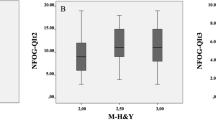Abstract
The symptoms of Parkinson’s disease (PD) worsen over time affecting performance and causing disability. The purpose of this study was to translate the Self-Assessment Disability Scale in patients with Parkinson's disease (SADS-PD) into the Serbian language and assess its validity and reliability. From January to July 2012, 114 consecutive PD patients were recruited at the Neurology Clinic in Belgrade. The inclusion criteria were: ability to walk independently for at least 10 m, ability to stand for at least 90 s. The exclusion criteria were: cognitive impairment, the presence of other major neurologic, psychiatric, visual, audio-vestibular, and orthopedic disturbances. The 25-item SADS-PD was translated according to internationally-accepted methodology. The internal consistency of the scale was evaluated using Cronbach’s alpha coefficient. Test–retest reliability was evaluated using Kendall’s concordance coefficient for total scores. To evaluate construct validity, an exploratory factor analysis (principal component analysis, varimax rotation) was performed. Cronbach’s alpha coefficient was 0.984. Kendall’s concordance coefficient was 0.994. Duration of the disease, Hoehn & Yahr (H&Y) stage, Unified Parkinson’s Disease Rating Scale (UPDRS) motor score, history of falls, Hamilton’s Depression and Anxiety Rating Scales (HDRS and HARS) scores were significantly correlated with the total SADS-PD score. On factor analysis 25 items in the SADS-PD questionnaire were separated in two clusters with total matrix variance of 79.7 %. The psychometric properties of the cross-culturally adapted SADS-PD questionnaire (Serbian version) have outstanding validity and reliability as an instrument for evaluation of the extent of disability in patients with PD.

Similar content being viewed by others
References
Rodriguez-Oroz MC, Jahanshahi M, Krack P, Litvan I, Macias R, Bezard E, Obeso JA (2009) Initial clinical manifestations of Parkinson’s disease: features and pathophysiological mechanisms. Lancet Neurol 8:1128–1139
Dal Bello-Haas V, Klassen L, Sheppard MS, Metcalfe A (2011) Psychometric properties of activity, self-efficacy, and quality of life measures in individuals with Parkinson disease. Physiother Can 63(1):47–57
Singer C (2012) Managing the patient with newly diagnosed Parkinson disease. Cleve Clin J Med 9(Suppl 2):S3–S7
Olanow CW, Stern MB, Sethi K (2009) The scientific and clinical basis for the treatment of Parkinson’s disease. Neurology 72(21 Suppl 4):S1–S136
Goetz CG, Fahn S, Martinez-Martin P et al (2007) Movement Disorder Society-sponsored revision of the Unified Parkinson’s Disease Rating Scale (MDS-UPDRS): process, format, and clinimetric testing plan. Mov Disord 22(1):41–47
Hoehn MM, Yahr MD (1967) Parkinsonism: onset, progression and mortality. Neurology 17:427–442
Wade DT (1992) Measurement in neurological rehabilitation. Oxford University Press, Oxford
Brown R, MacCarthey B, Jahanshai M, Marsden D (1989) Accuracy of self-reported disability in patients with Parkinson’s disease. Arch Neurol 46:955–959
Biemans MA, Dekker J, van der Woude LH (2001) The internal consistency and validity of the Self-Assessment Parkinson’s disease disability scale. Clin Rehabil 15(2):221–228
Hughes AJ, Daniel SE, Kliford I, Lees AJ (1992) Accuracy of clinical diagnosis of idiopathic Parkinson’s disease: a clinicopathological study of 100 cases. J Neurol Neurosurg Psychiatr 55:181–184
Folstein MF, Folstein SE, McHugh PR (1975) ‘Mini-Mental State’: a practical method for grading the cognitive state of patients with the clinician. J Psychiatr 12:189–198
Hamilton M (1967) Development of a rating scale for primary depressive illness. Br J Soc Clin Psychol 6:278–286
Hamilton M (1959) The assessment of anxiety states by rating. Br J Med Psychol 32:50–55
Guillemin F (1995) Cross-cultural adaptation and validation of health status measures. Scand J Rheumatol 24:61–63
Bland JM, Altman DG (1997) Cronbach’s alpha. Br Med J 317:572
Harrison MB, Wylie SA, Frysinger RC et al (2009) UPDRS activity of daily living score as a marker of Parkinson’s disease progression. Mov Disord 24:224–230
Sampaio C (2009) Can focusing on UPDRS Part II make assessments of Parkinson disease progression more efficient? Nat Clin Pract Neurol 5(3):130–131
Feinstein S, Feinstein R, Sabrow S (2010) Gender inequality in the division of household labour in Tanzania. Afr Sociol Rev 14(2):98–109
Fuwa M (2004) Macro-level gender inequality and the division of household labor in 22 countries. Am Sociol Rev 69(6):751–767
Harryson L, Novo M, Hammarström A (2012) Is gender inequality in the domestic sphere associated with psychological distress among women and men? results from the Northern Swedish Cohort. J Epidemiol Community Health 66(3):271–276
Doucet A (1995) Gender equality and gender differences in household work and parenting. Wom Stud Int Forum 18(3):271–284
Popović K (2007) Adult education and gender issues in Serbia. European infonet adult education. Available at: http://www.infonet-ae.eu/sw/articles/adult-education-and-gender-issues-in-serbia-0236
Tavakol M, Dennick R (2011) Making sense of Cronbach’s alpha. Int J Med Educ 2:53–55
Costello AB, Osborne JW (2005) Best practices in exploratory factor analysis: four recommendations for getting the most from your analysis. Pract Assess Res Eval 10(7):173–178
Spica V, Pekmezovic T, Svetel M, Kostic VS (2013) Prevalence of non-motor symptoms in young-onset versus late-onset Parkinson’s disease. J Neurol 260(1):131–137
Chaudhuri KR, Martinez-Martin P, Brown RG et al (2007) The metric properties of a novel non-motor symptoms scale for Parkinson’s disease: results from an international pilot study. Mov Disord 22:1901–1911
Ziemssen T, Reichmann H (2007) Non-motor dysfunction in Parkinson’s disease. Park Relat Disord 13(6):323–332
Acknowledgments
We sincerely appreciate Dr Richard G. Brown for allowing us to adapt the original version of the SADS-PD. The authors would like to thank Ivana Gligorijevic and Mitar Pljevaljcic for forward and backward translations of the SADS-PD as well as Professor Goran Trajkovic, for final statistical consultancy. This investigation was supported by the Ministry of Education and Science of the Republic of Serbia (Grants No 175087 and 175090).
Conflicts of interest
On behalf of all authors, the corresponding author states that there is no conflict of interest.
Author information
Authors and Affiliations
Corresponding author
Rights and permissions
About this article
Cite this article
Gazibara, T., Stankovic, I., Tomic, A. et al. Validation and cross-cultural adaptation of the Self-Assessment Disability Scale in patients with Parkinson’s disease in Serbia. J Neurol 260, 1970–1977 (2013). https://doi.org/10.1007/s00415-013-6906-2
Received:
Revised:
Accepted:
Published:
Issue Date:
DOI: https://doi.org/10.1007/s00415-013-6906-2



